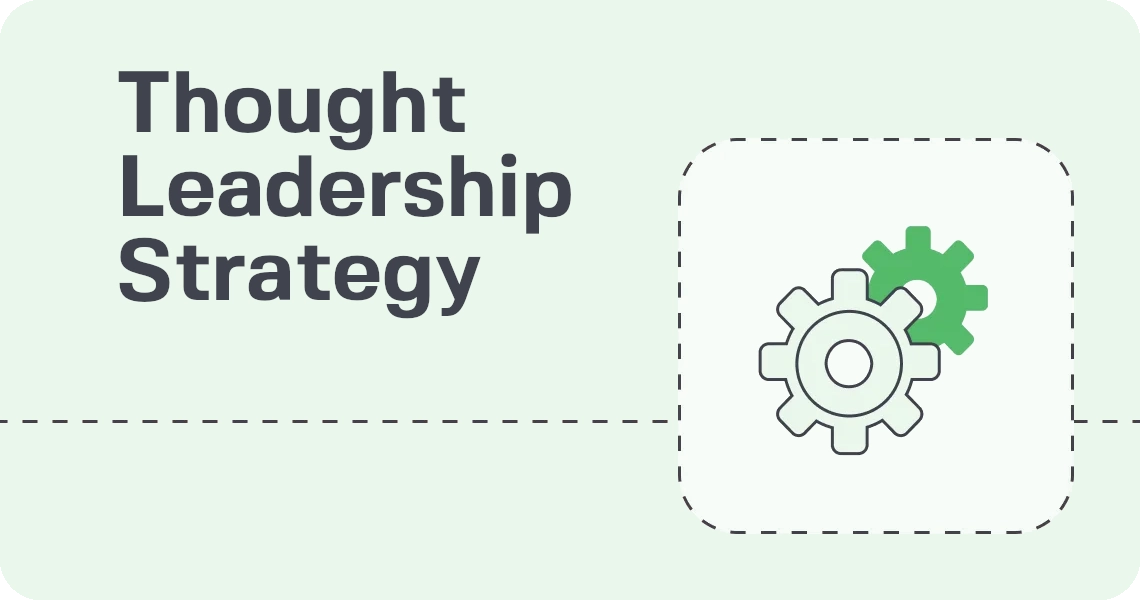Sundar Pichai was a freshman whom no one particularly important knew. At graduate school abroad, he was fascinated by the generous access to the school’s workstations. Having a computer all for himself was a whole new experience for the humble, introverted Sundar.
Today, Sundar is Google’s CEO. And one of the most prominent tech leaders in the world. He is proof that no obstacle is too great to overcome on the path to tech leadership greatness. Not your introverted nature. Not your foreign passport. And surely not growing up with scarce access to technology.
Sundar turned his unique circumstances and challenges into stepping stones toward leadership. How? Through a strategic blend of content marketing and thought leadership. His story validates the power of effective thought leadership marketing for tech CEOs.
Now, it’s your turn. What unique story will you tell?
What is thought leadership marketing?
As a hands-on, practical B2B thought leadership marketing team, we’re not much into definitions. However, if we had to provide a thought leadership marketing definition, it would be this: Sharing practical wisdom, original ideas, and useful solutions to complex problems to inspire engagement, build authority and trust, attract leads, and leave a lasting impact on the industry.
B2B thought leadership marketing is the key to standing out in the crowd. It helps you position yourself as a visionary leader. Even more importantly, it shows your human face by sharing personal stories of triumphs over obstacles or passionately discussing burning industry issues, including technology ethics. This helps tremendously in building meaningful relationships with customers, partners, and investors.
The 10 key elements of thought leadership marketing for tech
A tech CEO’s success is a combination of unique skills, experiences, and perspectives. However, there are general principles that, when applied, help you get the most out of your efforts.

Here, we cherry-picked the building blocks of successful B2B thought leadership marketing. These consistently emerged in our work with CEOs of global tech companies. And so we thought it would be great to share our insights with you—a thought leader in the making.
1. Clear personal brand
To become a recognized thought leader, a tech CEO needs a personal brand that resonates. Think of it as your professional signature—something that instantly signals who you are and what you stand for.
What does a personal brand include?
- Distinguishable identity
This is what makes you, you. It’s your unique blend of skills, values, and perspectives. Consider how someone like Jensen Huang from NVIDIA has built a recognizable identity around his passion for AI and his iconic leather jacket. To find your own, pinpoint your core values and weave them into your messaging. - Consistent Voice
Imagine if your favorite author suddenly started writing in a completely different style. It would feel like meeting an old friend who has changed so much you barely recognize him. - Consistency builds rapport and trust. Think of how Simon Sinek invariably and recognizably delivers messages of leadership and purpose, and follow in his footsteps.
- Credibility
To build credibility, offer unique insights that provide palpable value to your audience. A fresh perspective, new idea, or an insight that others haven’t yet shared can be extremely impactful. Especially when supported by data or real-world examples. - For instance, if you are a cybersecurity CEO, share examples of how you and your team prevented a known cyberattack. Show the drama, struggles, and suspense. People love good insider stories.
- Focus
You cannot be an expert at everything. Digital thought leadership marketing thrives on focus. Hence, define your niche expertise even if you’re a Renaissance person. Identify a particular area where you excel, deepen your mastery, and strengthen your focus. - Memorability
Make your content stick. Share simple, unexpected, concrete, credible, and emotional stories. Focus on quality over quantity, and use relatable examples to illustrate your points. - Alignment
Your personal brand should complement your company’s mission. Identify shared values, and ensure that they do not conflict with each other.
By building a strong and genuine personal brand, you’ll be well on your way to true tech leadership.
2. Authenticity
“To say that something is authentic is to say that it is what it professes to be, or what it is reputed to be, in origin or authorship.” (Stanford Encyclopedia of Philosophy)
Authenticity is rare to find and difficult to achieve and for these reasons, all the more valuable in a world saturated with content. It’s not something that adds extra value to your B2B thought leadership marketing. It is its foundation—effective thought leadership hinges on authenticity.
Sharing genuine experiences and know-how, instead of impersonal or overly polished theoretical remarks, is the path for any aspiring thought leader. It’s what allows people to connect with your message.
Authenticity doesn’t have to be a pipe dream, even with tight schedules. Reduce your workload by delegating content creation to your team. Share your authentic ideas and insights with wordsmiths, and let them refine the language while preserving your voice. And always ensure you review the final thought leadership content ideas before publication.
For examples of authentic thought leadership content marketing, consider:
- IBM’s Think, known for its in-depth, data-driven insights
- Deloitte Insights, which features diverse perspectives and real-world case studies
- Gartner for Marketing, which provides practical, actionable advice
3. Industry expertise
Industry expertise goes beyond familiarity with established industry practices. It involves a deep understanding of the latest technologies, trends, regulations, and challenges, but it’s also much more than that.
A tech thought leader’s applied expertise is:
- Specialized: A thought leader is deeply focused on highly specific themes within a concrete niche. For instance, she tackles topics related particularly to API security or incident response, not both.
- Data-based: She relies on hard data, authoritative sources, and reliable research from sources such as peer-reviewed journals and government statistics.
- Innovative: She synthesizes existing knowledge to develop novel insights that resonate with peers, clients, and prospects.
- Actively contributing: She actively contributes to industry conversations, regularly publishing helpful articles, reports, and webinars and participating in conferences and events to share her knowledge.
4. Consistent content creation
Sporadic content creation yields limited results. A consistent publishing schedule, guided by a well-planned editorial calendar, on the other hand, is a tested-and-proven strategy.
However, consistent content creation is as much about quality as it is about regularity. Hence, avoid producing frequent but low-value content. Instead, create thought leadership content that directly addresses your audience’s perplexities and needs. That includes clear, empathetic, and engaging articles, videos, and social media posts. If you lack the time or inspiration to create new pieces, repurpose existing content.
Balance long-form and short-form content to avoid producing articles lacking value and to decrease your workload. Diverse content formats also allow you to target diverse audience groups, as not everyone prefers white papers, lengthy studies, or 3,000-word blog posts.
Consistent content creation breeds reliability and trust, creates a fertile ground for audience engagement, leads to new opportunities for networking and industry influence, and demonstrates professionalism, punctuality, and involvement in your audience’s world.
5. Multi-channel presence
Don’t just stick to one platform. Think of your thought leadership content like a message in a bottle—you want it to wash up on as many shores as possible.
Let’s say you’ve got some killer insights on GenAI trends. Here’s how to spread the word: Start with a detailed article on your blog. Then, pull out the key takeaways and share them as quick posts on LinkedIn and X. Dive deeper in a webinar, and create short, punchy videos for TikTok and YouTube.
But that’s just the beginning. Jump into influential podcasts, host webinars, and speak at important conferences. Send out email newsletters with your latest thoughts. Write guest posts for industry publications. Host or co-host events. Get involved in discussions on forums, Reddit, and anywhere else your audience hangs out.
That is what an omnichannel approach is all about—being everywhere your audience is. It might not bring in a flood of leads overnight, but it’ll help you expand your network, and that’s a huge win.

6. Data-driven insights
Want people to really listen to what you have to say? Back up your claims with evidence.
The best way to do this is to rely on hard data. Think industry benchmarks, customer behavior analytics, market research studies, and performance metrics. That way, when someone questions your ideas, you’ve got the proof to back them up.
Don’t hesitate to use external reports and studies. You can’t possibly research every industry topic yourself. So, use confirmed authoritative sources to draw useful new conclusions.
But if you have the time and resources, original research is a game-changer. It adds credibility to your thought leadership, and it will make you stand out. Research and publish your results in white papers, case studies, or reports. If your audience finds them helpful, you will see positive marketing results.
For great examples of original, authoritative reports, check out Gartner and Forrester. Take a look at IBM’s yearly “Cost of a Data Breach Report” or Salesforce’s annual “State of Sales Report,” too.
7. Engaging storytelling
Humans are naturally drawn to stories. For thousands of years, we’ve shared knowledge through storytelling. Even with all the tech and social changes, our desire for a good story hasn’t faded away.
Lisa Cron, the author of Wired for Story, says readers are always looking for three things right from the start:
- Whose story is this?
- What’s happening?
- What’s at stake?
As the story unfolds in the interplay between these three elements, a good storyteller answers the questions by nudging the reader forward to the finale. And you don’t need to be Haruki Murakami to be able to do this. We are all capable of it to some extent.
Time constraints can often lead to neglecting storytelling principles. We tend to prioritize meeting deadlines at the expense of a good story. But even then, instead of just throwing out dry facts or sales pitches, try to incorporate narrative elements into industry discussions. Create content that people remember, that builds connections, and that inspires them to act.
Think about sharing success stories, personal challenges you’ve overcome, behind-the-scenes glimpses into the industry, or lessons you’ve learned. These all make great stories. If you need inspiration, check out Johnson & Johnson’s Personal stories for good thought leadership examples.
8. Collaboration with media and influencers
Want to get your ideas out to a wider audience? Partnering with industry experts, journalists, or influencers is an excellent way to do it. These people have become trusted authorities for a reason. So, when you collaborate with them, some of that trust transfers to you.
Think about contributing to big tech publications, like Wired, TechCrunch, or Forbes, or participating in thought-provoking interviews. Collaborating on major reports, participating in expert panels, and co-creating engaging content, like webinars and podcasts, are all worthwhile strategies as well.
So, find ways to team up with people who are already making waves in your industry and extend your reach.
9. Active community engagement
When you think about it, community engagement is why you do thought leadership marketing. After all, your efforts are futile if there’s no response from your audience.
To build a strong community:
- Encourage interaction
- Invite your community to share opinions on industry problems, trends, and developments
- Encourage followers to share experiences, challenges, or solutions, and include their ideas in your thought leadership content
- Respond promptly to comments, questions, and feedback
- Create dialogue
- Host conversations in the form of live Q&A events, panel discussions, webinars, or casual AMA (Ask Me Anything) sessions
- Cultivate LinkedIn thought leadership by actively engaging in professional discussions
- Build connections
- Build relationships through networking and events
- Collaborate with other thought leaders
- Join industry groups
- Contribute to community-driven initiatives
These tactics promote meaningful connections and can strengthen your position as a thought leader.
10. Measuring impact
To know whether your B2B thought leadership plan works, you have to track your marketing efforts. It’s all about picking the right things to measure so you know what works and what doesn’t. And, of course, having the right tools to tweak your strategy as well as keep an eye on numbers and performance is key to seeing a real return on your efforts.
At 42DM, we’ve worked with many tech CEOs over the years. The ones who see the best results usually focus on a short, carefully chosen list of metrics.

Conclusion
There you have it—ten key elements to dial up your B2B thought leadership marketing game.
Thought leadership for tech CEOs is about communicating your authentic insights and connecting with people. It’s about sharing aha moments, telling memorable stories, and becoming the person others turn to when they need no-nonsense wisdom.
Think of it as the pursuit of building a community around what people genuinely care about. Frankly, that kind of community is gold in the tech world.
So, grab these ideas, add your spin, and get out there and lead. After all, your unique perspective is your superpower—use it to shape the tech future.












